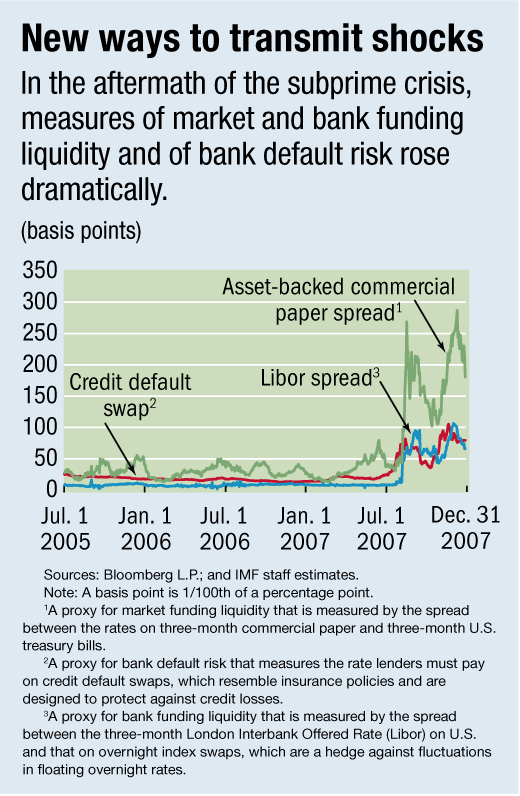
Typical street scene in Santa Ana, El Salvador. (Photo: iStock)
IMF Survey: New Channels Spread U.S. Subprime Crisis To Other Markets
September 23, 2008
- New conduits for liquidity shocks help explain rapid spread of subprime crisis
- Initial credit problem became liquidity issue, then solvency problem
- Important financial institutions in the United States, Europe were affected
New channels spread the mid-2007 turbulence in the U.S. subprime mortgage market to other U.S. and foreign markets.

Bankrupt investment bank Lehman Brothers: financial institution insolvency was key channel for spreading subprime crisis (photo: Nicholas Roberts/AFP)
CONTAGIOUS LIQUIDITY SHOCKS
Our analysis suggests that financial innovations and closer links between banks helped transform what started last year as a liquidity crisis into a solvency issue for financial institutions.
Liquidity shocks, transmitted through these new channels, help explain the rapid transmission of turbulence that began in the relatively small U. S. subprime mortgage market to other financial markets in the United States and abroad.
Our analysis suggests that innovations—such as structured credit products and the increased ability of banks to move risk off their balance sheets—as well as closer links between large, complex banks were at least in part responsible for those new, or in some cases enhanced, transmission channels.
Liquidity interactions
A number of transmission mechanisms were established during the recent period of turbulence, either through increased strains in market liquidity or funding liquidity, or even through default risks.
• Market liquidity measures the ease with which asset positions can be traded without significantly affecting their corresponding price.
• Funding liquidity refers to the availability of funds for solvent agents needing to borrow in the market to service their obligations.
In tranquil periods, market illiquidity shocks are typically short lived because they create opportunities for traders to profit and, in doing so, provide liquidity and contribute to the price-discovery process of financial assets—for example, when arbitrageurs discover price differences between two markets and try to profit from the wider spread. By so doing they bring funds to the thinner market and reduce the price differentials.
Systemic risks
But during periods of crisis, normally short-lived shocks may instead amplify and propagate liquidity shocks across financial markets, creating systemic risks. These mechanisms can operate through direct linkages between the balance sheets of financial institutions—where, for example, institutions are counterparties, that is, on either side of a transaction.
In periods of stress, counterparty problems can generate systemic risks through so-called "domino" effects, where shocks propagate across financial institutions that have assets or liabilities directly linked to each other through the payments system.
But they can also operate indirectly through declining asset prices, exacerbated as institutions sell assets to reduce their risk. Financial institutions value those assets at current market price and, if the value of the assets significantly declined from their original price, the creditworthiness of the institutions will deteriorate. In this case, leverage—investing with borrowed funds—is procyclical and can amplify the financial cycle as institutions sell assets to pay down debt and in the process trigger further declines in the price of those assets.
The subprime crisis
The initial shock—the deteriorating quality of U.S. subprime mortgages—was a credit and not a liquidity event. But it rapidly transformed into a liquidity and then a solvency issue.
Increased delinquencies on subprime mortgages resulted in uncertainty surrounding the value of a number of asset-backed securities that had these mortgage assets in their underlying portfolios. Rating agencies downgraded many of the securities to reflect the deterioration in quality of the underlying portfolio and announced changes in their methodologies for rating such products.
Meanwhile, because the values of the assets underlying the securities rapidly declined, the liquidity in secondary markets for what had been tradable securities evaporated. The losses, downgrades, and changes in methodologies shattered investors' confidence in the rating agencies' abilities to evaluate risks of complex securities, causing them to pull back from structured products in general.
Spreading the effects
There were several important channels through which the crisis that began in the subprime market was passed on:
• Asset-backed commercial paper (ABCP) funding liquidity. Special entities, such as structured investment vehicles (SIVs) and conduits, bought asset-backed securities and funded the purchase by selling short-term commercial paper. Because the commercial paper was repaid from the income from the asset-backed securities, the increasing uncertainty with regard to the value of underlying securities made investors such as money market mutual funds unwilling to roll over the ABCP.
• Bank funding liquidity. The SIVs, many of them sponsored by banks, had to call on contingent credit lines with those banks to replace the commercial paper funding. The balance sheets of those financial institutions were strained, and the strains were exacerbated because of the declining values of the underlying asset-based securities. As a result, the level of interbank lending declined—both because banks had to fund their SIVs and because banks worried about the credit risk of lending to other institutions.
• Market liquidity and volatility. As turbulence from U.S. subprime mortgages increased, financial markets more generally showed signs of stress, because investors moved from complex structured securities products in a flight to the safest and most liquid assets, such as U.S. treasury bonds. Furthermore, lenders increased margin requirements on hedge funds that held asset-backed securities and other structured products, adding to the burden on those large investors and, in turn, to greater market volatility.
• Financial institution solvency. The crisis brought to the forefront concerns about the soundness of some of the largest banks, as witnessed by the collapse of the New York investment banks Bear Stearns and Lehman Brothers; Merrill Lynch & Co.'s sale to Bank of America; and insurance company AIG's crisis. The values of the securitized mortgages and structured securities on the balance sheets of financial institutions declined, resulting in extensive writedowns. Funding liquidity pressures forced rapid sales of assets at depressed asset prices. Moreover, refinancing costs increased due to rising money market spreads, amplified by banks' increasing reliance on wholesale funding.
Finding the linkages
We adopted an empirical framework to evaluate the transmission of liquidity shocks across the relevant market segments. Our model was estimated using daily data from January 2003 to January 2008. We used five variables as proxies for overall market liquidity, funding liquidity, default risk, and volatility to examine linkages across different channels and what changed in their relationships after concerns about the quality of subprime mortgages became widespread.

We found that markets that operated virtually or totally independently before the subprime crisis began to move together afterward, evidence that new channels of liquidity shocks were established during the second half of 2007. There was a simultaneous and dramatic increase in three crucial measures (see chart) at the onset of the subprime crisis.
The results of a pronounced interaction between market and funding liquidity are consistent with the emergence of reinforcing liquidity spirals, in which problems fed back on each other and were amplified. After the initial period of illiquidity, the U.S. subprime crisis increasingly became one of insolvency in Europe and especially the United States.
Comments on this article should be sent to imfsurvey@imf.org







